Creating a natural medicine cabinet is more than just health—it’s about mixing wellness with style. Today, many people are looking for diy medicine cabinet ideas that are both beautiful and useful. Your cabinet can be a quick go-to for natural remedies when regular medicines don’t work.
Imagine a space where jars of dried herbs and essential oil blends sit together. This cabinet is designed to be both beautiful and easy to use. This guide will show you how to make a pinterest-perfect natural medicine cabinet. You’ll learn about choosing the right containers and organizing your remedies for all seasons. It’s perfect for both beginners and experienced herbalists, combining practicality with creativity.
Key Takeaways
- A well-organized cabinet holds herbs that treat colds, respiratory issues, and more.
- Use herb jars and storage ideas to keep remedies fresh for up to a year.
- Blend aesthetics with function using apothecary decor and color-coded labeling.
- Custom diy medicine cabinet designs fit any home style, from rustic to modern.
- Included guides and seasonal updates ensure your cabinet stays effective and stylish.
Understanding the Benefits of a Natural Medicine Cabinet
Creating a holistic health cabinet is more than just a convenience. It’s a move towards taking charge of your health. These cabinets mix usefulness with wellness, following healthy living tips that focus on long-term health.
Health Advantages of Natural Remedies
Natural remedies, like chamomile tea for sleep or ginger for nausea, work with your body. They don’t fight against it like some medicines do. Herbs like white willow bark for pain and MSM for joint pain tackle the root of the problem, not just the symptoms.
Essential oils, like lavender for relaxation, provide targeted relief without harsh chemicals. They’re diluted with carrier oils to ensure safety and effectiveness.
Cost Savings Over Conventional Medicine
- Herbs like echinacea for cold relief are cheaper than over-the-counter cold meds.
- Packaged essential oil roll-ons, like peppermint for headaches, save money over frequent pharmacy trips.
- Buying bulk herbs (e.g., turmeric) is more cost-effective than processed supplements.
These choices can lead to significant savings over time, without sacrificing quality care.
Environmental Impact Considerations
A well-organized cabinet helps reduce waste. Using reusable glass jars for herbs and carrier oils reduces plastic waste. Natural ingredients avoid harmful chemicals that pollute our water systems.
Choosing brands that source sustainably makes your holistic health cabinet eco-friendly. Small changes like these can make a big difference in both your health and the planet.
Selecting the Perfect Cabinet or Storage Solution
Choosing the right diy medicine cabinet is all about finding the right mix of style and function. You might want a rustic shelf or a sleek, mirrored cabinet. Your choice affects how you store herbal remedies and how easy it is to reach them. First, measure your space carefully.
Consider wall-mounted options like the Allen + Roth 22.5″x27.5″ cabinet. It fits well in tight spots. Or, look at the Ciaran Medicine Cabinet Mirror (26.75”Hx17.5”Wx4.5”D), which has hidden shelves behind glass.
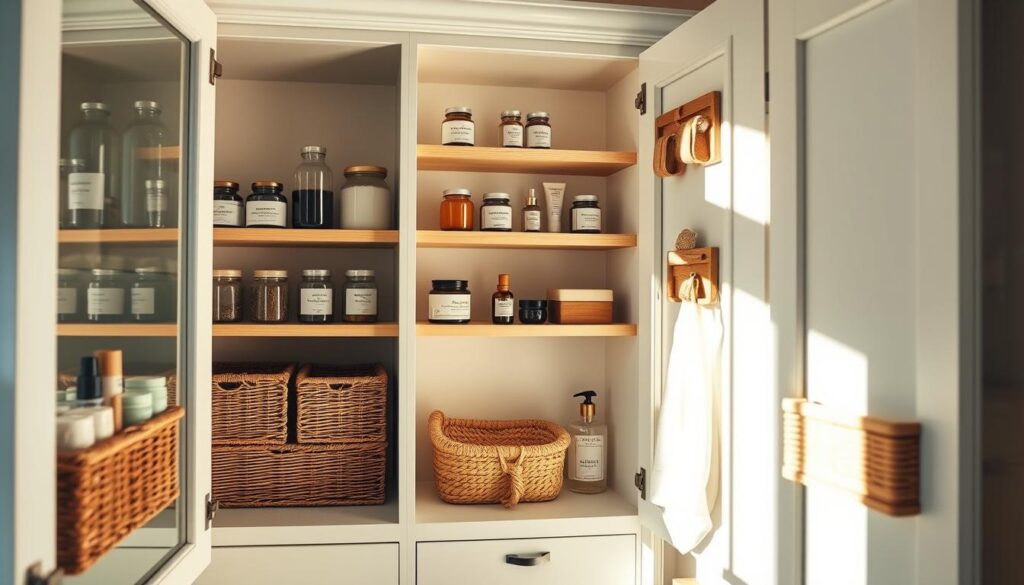
The material of your cabinet is important too. Wooden cabinets keep dried herbs dry, while mirrored ones add a modern touch. For small areas, think about recessed designs or wellness organization ideas like niche shelves from old cabinets.
Farmhouse or boho styles can include woven baskets for loose herbs.
- Humidity control: Choose fog-free models like the Sleek Anti-Fog LED Cabinet to keep tinctures and oils fresh.
- Customization: Adjustable shelves in the Ciaran mirror are great for organizing supplements, salves, and linens.
- Repurpose: Turn an old dresser into a herbal remedies storage unit. Paint it chalkboard for labeling jars.
Pair glass-front cabinets with dark-colored jars to protect herbs from light. Mix open shelving with drawers for easy access to essentials. A well-thought-out diy medicine cabinet should be both welcoming and practical. It should feel like a tiny wellness haven in your home.
Essential Tools and Materials for Your DIY Project

Make your space better with a diy medicine cabinet. First, pick a base. Thrift stores have old cabinets for $20–50. IKEA’s BILLY bookcase, turned into a cabinet, costs about $100. Old dressers or wall shelves save money and reduce waste.
Cabinet Options: New, Upcycled, or Repurposed
Choose eco-friendly options like reclaimed wood or FSC-certified pine. Thrifted items add character and save money. For instance, a 1950s apothecary cabinet, painted with safe colors, becomes a highlight.
Decorative Elements That Enhance Functionality
Bring style with wellness ideas like chalkboard labels ($5–10 per quart). Use glass jars from Walmart. Mix recycled jars with cork stoppers for herbal remedies. Wooden shelves with natural finishes add a touch of earthiness.
| Tool | Material | Use |
|---|---|---|
| Compound miter saw | 1×6 clear pine | Cutting cabinet frames |
| Drill | Recycled glass bottles | Securing hardware |
| Paintbrushes | Chalkboard paint | Custom labels |
Organization Tools for Maximum Efficiency
Use stackable containers from The Container Store or Dollar Tree for space. Spice racks are great for small bottles. Card catalog cabinets from eBay or Habitat for Humanity stores offer sleek storage. Color-code with washi tape for quick access.
How to Build a Pinterest-Perfect Natural Medicine Cabinet: Step-by-Step Guide
Turn your space into a diy medicine cabinet that’s both beautiful and useful. Begin by clearing a well-lit area and getting materials like sandpaper, non-toxic paint, or eco-friendly contact paper. Always wear gloves and a mask when sanding or painting for safety.
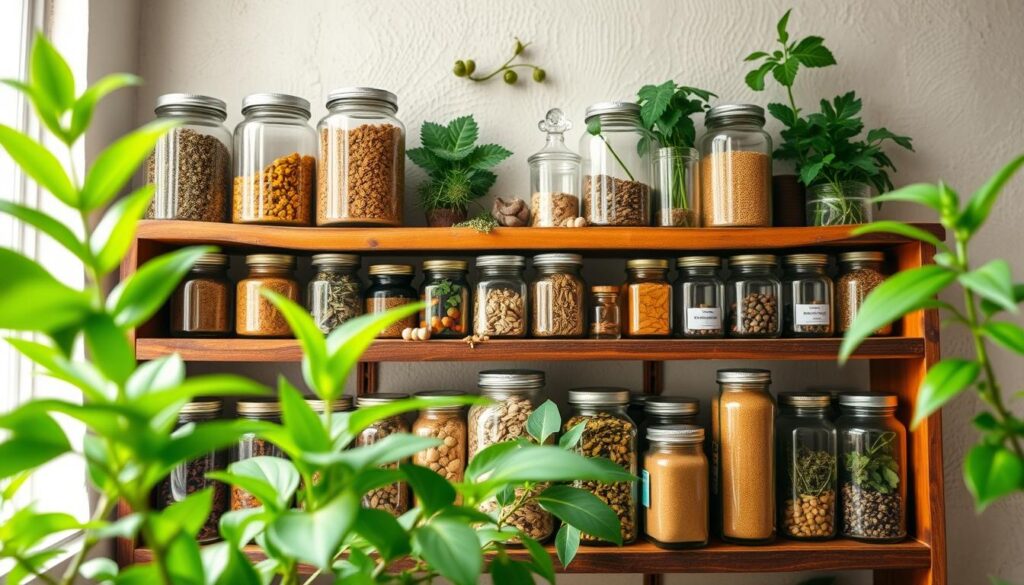
Preparing Your Space and Materials
- Measure walls or shelves to ensure a perfect fit
- Reuse glass jars or metal tins for eco-friendly storage
- Invest in a $6 roll of contact paper for quick cabinet face-ups
Assembly Instructions for Different Cabinet Types
Choose your approach:
- Purchased cabinets: Mount securely using wall anchors. Add interior dividers for wellness organization ideas.
- Upcycled pieces: Sand vintage cabinets, then stain or paint. Attach hooks for hanging herb bundles.
- DIY shelving: Build a floating shelf unit. Install LED strips for ambient lighting.
Finishing Touches for That Pinterest-Worthy Look
Add charm with pressed herb coasters or botanical decals. Hang a small chalkboard for remedy labels. For a rustic touch, distress painted surfaces with sandpaper. Display dried lavender or eucalyptus sprigs in mason jars.
Accessorize with woven baskets for loose herbs or a small tray for essential oil rollers. Align items symmetrically for a Pottery Barn-inspired look. Lastly, test lighting to highlight your how to build a pinterest-perfect natural medicine cabinet masterpiece.
Must-Have Herbs and Natural Remedies to Stock
Building your holistic health cabinet begins with picking natural remedies for everyday needs. Here’s a list of must-haves to keep your family healthy and ready for common illnesses.
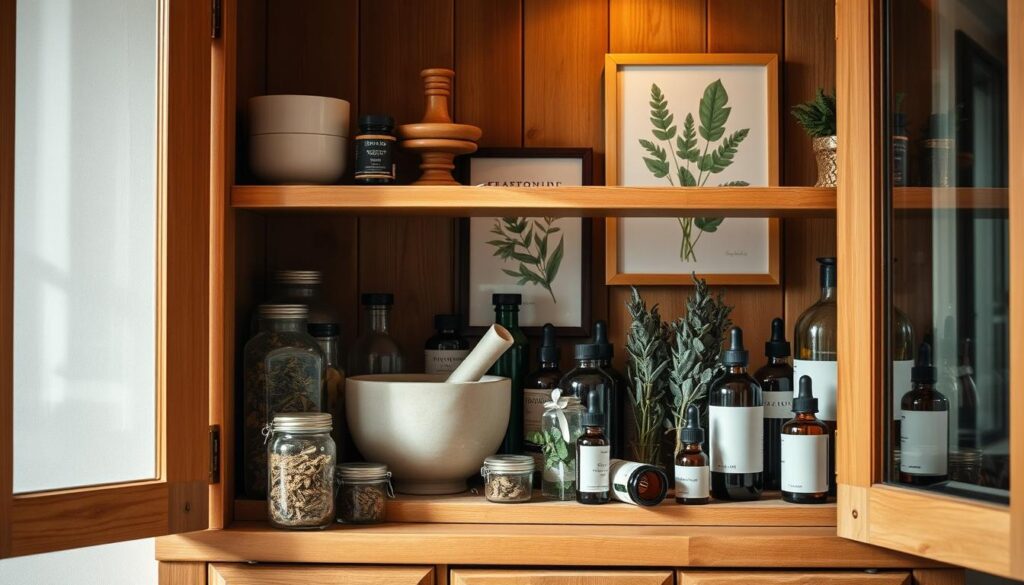
- Immune Support: Echinacea, elderberry, and vitamin C help fight off colds and flu.
- Pain Relief: White willow bark, arnica, and turmeric help with inflammation and pain.
- Digestive Aids: Ginger, peppermint, and slippery elm ease stomach problems and bloating.
- Respiratory Relief: Elderberry syrup, eucalyptus, and steam treatments with essential oils help with congestion.
- Skincare: Calendula and coconut oil help heal minor cuts and irritation.
| Herb | Primary Use | Storage Tips |
|---|---|---|
| Echinacea | Immune system support | Store dried roots in airtight jars |
| Lavender | Calms anxiety and wounds | Seal in dark glass bottles |
| Ginger | Relieves nausea and pain | Freeze fresh ginger slices for long-term use |
| Capsicum | Pain relief topical | Keep tinctures in cool, dark spaces |
Proper herbal remedies storage keeps them potent. Store dried herbs in airtight containers, away from light. Tinctures and oils stay good longest in dark glass. For a holistic health cabinet, choose items like chamomile (for sleep and digestion) or calendula (for skin and wounds). Start small and add more as needed. Always buy herbs from trusted sources for the best quality.
Organizing Your Supplies for Both Beauty and Function
Turn your diy medicine cabinet into a spot that looks good and works well. Good mean your remedies are easy to find and your space stays neat. We’ll look at ways to make it both pretty and practical, without losing access.
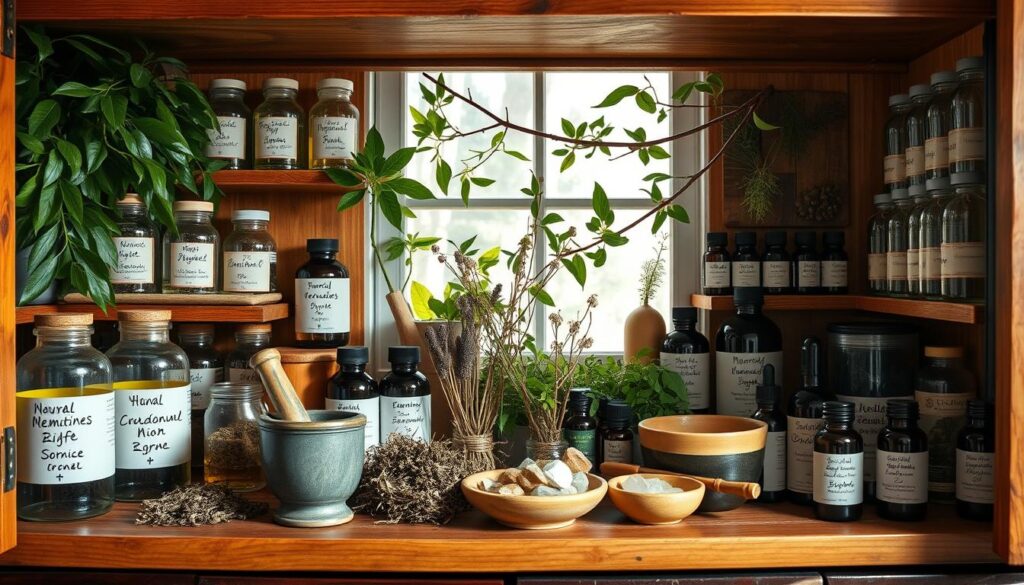
Color-Coding and Labeling Systems
Color-code items by their use—red for first aid, green for sleep aids, or blue for immune boosters. Use waterproof labels (like chalkboard or adhesive tags) for clear signs. Add personal touches like botanical art or handwritten labels for a unique feel.
Creative Storage Solutions
- Store dried herbs in herbal remedies storage jars on open shelves or hanging racks.
- Use stackable tins for salves and small items; attach magnetic strips to cabinet doors for easy access.
- Install LED lighting inside cabinets for better visibility and a modern vibe.
Accessibility Considerations
Put often-used items like vitamins or cough syrups at eye level. Use childproof locks if you need to. Keep track of expiration dates with a small calendar or digital app. Choose clear containers to see when you’re running low.
Essential Oils Collection: Storage and Display Ideas
Keeping essential oils fresh starts with smart storage. A holistic health cabinet does best when oils are stored safely. Use these eco-friendly tips to mix function with flair.
Safety Considerations for Essential Oil Storage
Store oils in eco-friendly medicine storage like amber or cobalt glass. Keep them away from heat and sunlight to keep them potent. Use childproof containers and label them well. Also, install vents to prevent strong smells.
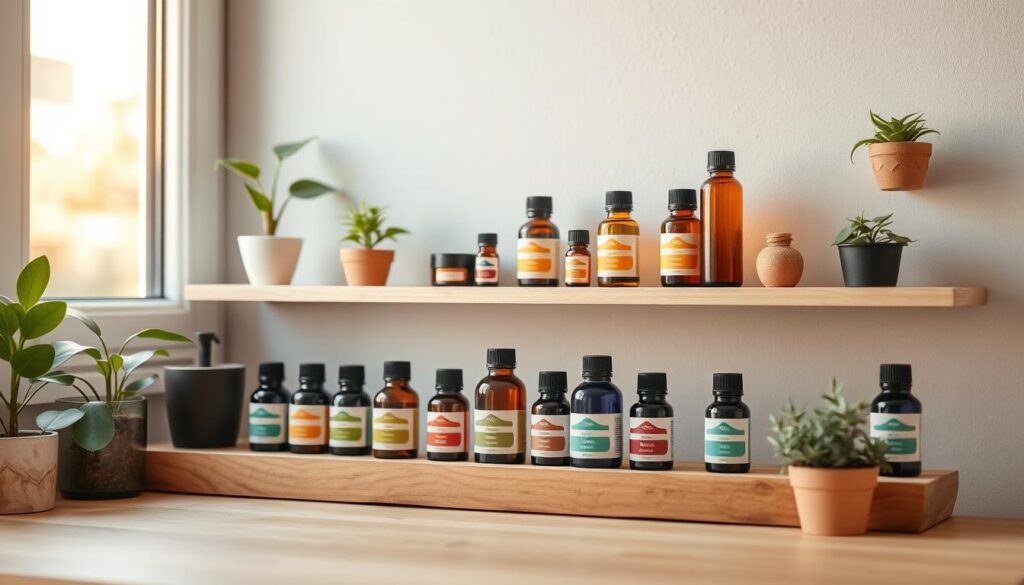
Creative Display Options That Maximize Space
Turn your storage into a wellness display with these wellness organization ideas:
- Zebrawood racks with epoxy resin hold 5ml and 15ml bottles securely
- Upcycled picture frame shelves add rustic charm while saving counter space
- Floating shelves with spice cabinet compartments create sleek, visible storage
- Hanging organizers maximize vertical space in small bathrooms or kitchens
- Art studio bins group oils by scent families for easy access
Use recycled materials like reclaimed wood or vintage tins for eco-friendly storage. Combine usefulness with beauty to make your cabinet both useful and motivating.
Sustainable and Eco-Friendly Cabinet Maintenance
Keeping your eco-friendly medicine storage system in top shape is key. It ensures your holistic health cabinet remains safe and effective. Start by cleaning surfaces with natural solutions that avoid harsh chemicals. Here’s how to care for your cabinet while keeping your remedies safe:
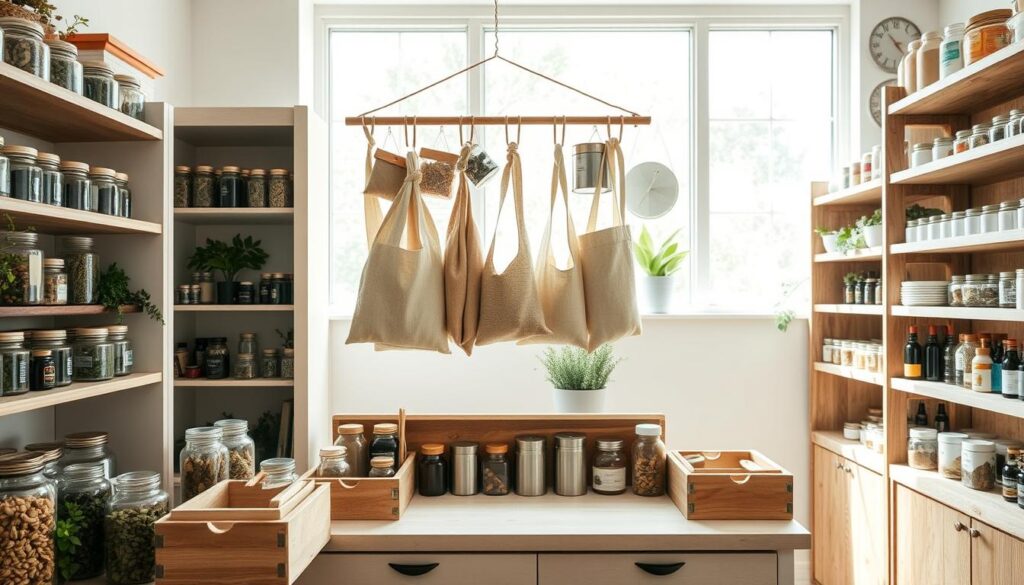
- Use white vinegar and water to disinfect shelves weekly—this non-toxic mix works on glass and metal surfaces.
- Store dried herbs in airtight jars with rice packets to absorb excess moisture naturally.
- Replace expired items by composting plant-based materials like chamomile or ginger scraps.
| Surface | Cleaning Solution |
|---|---|
| Wood | Coconut oil + lemon juice polish |
| Glass | Equal parts water and vinegar |
| Metal | Baking soda paste for tarnish |
Choose reusable containers made from glass or stainless steel to cut down on plastic waste. When repainting cabinets, pick eco-friendly options like Soy-Gel Professional Paint Remover or Real Milk Paint to avoid VOCs. Schedule quarterly checks to rotate stock and ensure all healthy living tips align with your cabinet’s purpose. Small steps like these turn your holistic health cabinet into a cornerstone of sustainable wellness.
Seasonal Updates to Keep Your Natural Medicine Cabinet Fresh
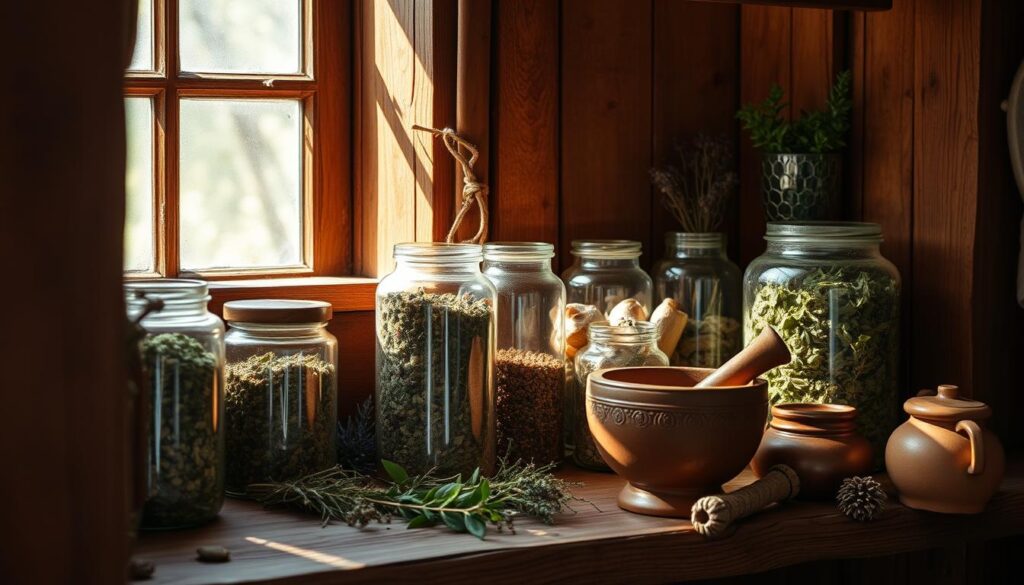
Change your natural remedies with the seasons to stay ready. In spring and summer, use lighter blends for allergies and sunburns. Keep lemon balm for stress and lavender oil for bug bites handy.
For fall and winter, focus on boosting immunity with echinacea and astragalus. Trust Earthley Wellness and Boiron Oscillococcinum for seasonal colds.
- Spring/Summer: Add Organic Olivia Spring Defense for allergies. Store dried herbs in glass jars with tight lids.
- Fall/Winter: Include elderberry syrup and reishi tinctures. Use carrier oils for infused skincare remedies.
- Year-Round: Track expiration dates with a calendar app or sticky notes. Replace dried herbs every 6-12 months.
Healthy living tips include changing herbal remedies every 3-4 months. Check expiration dates monthly with a checklist. For herbal remedies storage, keep tinctures in cool, dark places. Replace eucalyptus oil yearly and update labels as seasons change.
Winter must-haves like ginger tea blends and honey lozenges last longest in airtight containers. Summer favorites like peppermint oil refresh summer routines. Follow these steps to keep your cabinet vibrant and effective all year:
- Spring: Toss expired chamomile and restock with fresh lemon balm.
- Summer: Add calendula salves for sunburns and rosemary oil for energy.
- Fall: Introduce astragalus root and bitters for digestion.
- Winter: Store elderberry syrup and elecampane for respiratory health.
Adjusting your cabinet seasonally ensures natural remedies work best when you need them most. Small swaps keep wellness accessible and in tune with nature’s rhythms.
Conclusion: Embracing Natural Wellness with Your Picture-Perfect Cabinet
Creating a Pinterest-perfect natural medicine cabinet is more than looks. It’s a step toward a healthier life. By following guides like how to build a pinterest-perfect natural medicine cabinet, you’ve mixed practicality with style. This space is not just for storage; it’s a daily reminder of your commitment to holistic health.
Experts like Dr. Katie Wood say natural remedies work best with a holistic approach. Her journey from conventional medicine to using herbs, acupuncture, and whole foods shows the power of a holistic health cabinet. Combining remedies with healthy meals, regular exercise, and mindful habits strengthens your health.
Let your cabinet grow with your family’s needs. Healthy living tips suggest making storage personal to your wellness goals. Use decorative jars for teas or essential oils, and change out seasonal ingredients like elderberry syrup in winter. Sharing your creations on Pinterest inspires others and celebrates your progress.
Every step toward natural wellness counts. Whether it’s eco-friendly storage or organic oils, your choices benefit your health and the planet. Keep exploring, stay curious, and let your cabinet evolve with you. Your journey to a healthier, more balanced life starts here.



